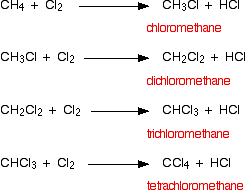
Methane and chlorine
 المؤلف:
..................
المؤلف:
..................
 المصدر:
LibreTexts Project
المصدر:
LibreTexts Project
 الجزء والصفحة:
.................
الجزء والصفحة:
.................
 24-7-2019
24-7-2019
 996
996
Methane and chlorine
If a mixture of methane and chlorine is exposed to a flame, it explodes - producing carbon and hydrogen chloride. This is not a very useful reaction! The reaction we are going to explore is a more gentle one between methane and chlorine in the presence of ultraviolet light - typically sunlight. This is a good example of a photochemical reaction - a reaction brought about by light.
CH4+Cl2+energy→CH3Cl+HCl
The organic product is chloromethane. One of the hydrogen atoms in the methane has been replaced by a chlorine atom, so this is a substitution reaction. However, the reaction doesn't stop there, and all the hydrogens in the methane can in turn be replaced by chlorine atoms. Multiple substitution is dealt with on a separate page, and you will find a link to that at the bottom of this page.
Substitution reactions happen in which hydrogen atoms in the methane are replaced one at a time by chlorine atoms. You end up with a mixture of chloromethane, dichloromethane, trichloromethane and tetrachloromethane.


The original mixture of a colorless and a green gas would produce steamy fumes of hydrogen chloride and a mist of organic liquids. All of the organic products are liquid at room temperature with the exception of the chloromethane which is a gas.
If you were using bromine, you could either mix methane with bromine vapor, or bubble the methane through liquid bromine - in either case, exposed to UV light. The original mixture of gases would, of course, be red-brown rather than green.
You wouldn't choose to use these reactions as a means of preparing these organic compounds in the lab because the mixture of products would be too tedious to separate. The mechanisms for the reactions are explained on separate pages.
Alkanes (the most basic of all organic compounds) undergo very few reactions. One of these reactions is halogenation, or the substitution of a single hydrogen on the alkane for a single halogen to form a haloalkane. This reaction is very important in organic chemistry because it opens a gateway to further chemical reactions.
 الاكثر قراءة في مواضيع عامة في الكيمياء العضوية
الاكثر قراءة في مواضيع عامة في الكيمياء العضوية
 اخر الاخبار
اخر الاخبار
اخبار العتبة العباسية المقدسة


